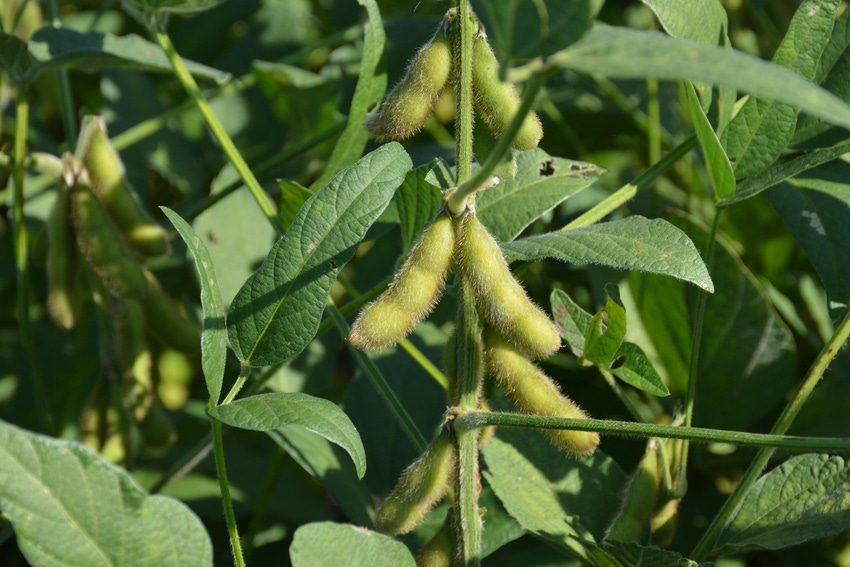
One of the misconceptions in the soybean world is that foliar fertilizer applied at the beginning pod stage will work to provide nutrients and help improve yields. It turns out that isn’t the case.
Two years of data from research conducted across 16 states in 46 different environments showed no yield benefit of foliar fertilizer applied at the R3 growth stage in absence of a nutrient deficiency.
The foliar fertilizer misconception was among a number of topics Extension soybean specialists from across the United States — who are part of the United Soybean Board’s Science for Success Program — discussed in a recent webinar.
Other misconceptions include extra nitrogen fertilizer is needed in a high yield environment; yield enhancing products can boost soybean yields through pod retention and improved canopy health; farmers can get by on liquid fertilizer alone; and automatic fungicide sprays are needed to protect yields. None of these are true, the soybean specialists say.
Some of the talk is that in this era of high fertilizer prices, farmers will turn to all liquid fertilizer to save money. Shaun Casteel, Extension soybean specialist at Purdue University, stressed that liquid fertilizer will not supply the macro needs of the soybeans although it may supply some of the micronutrients.
To that point, Chad Lee, Extension soybean specialist at the University of Kentucky added that Casteel gave a very diplomatic answer. “If you can get by on liquid fertilizer in beans, you can get by without fertilizer,” Lee stressed, a point Casteel said he 100% agrees with.
Moreover, Casteel said adding nitrogen to soybeans in a high yield environment really isn’t the way to go, even if you are shooting for 100-bushel yields. He said the starting point really is to establish good root development, nodules and fixation to supply the nutrients the plant actually needs. He stressed establishing a good root system is the key to higher yields.
Casteel said another misconception that isn’t true is that yield enhancing products can increase soybean yields through pod retention and better canopy health. Research funded by the United Soybean Board across the United States debunked the claim.
“Our results are very clear: there really is no such thing as a magical potion or fairy dust that we can add to soybeans to actually increase yield beyond the potential of any given point. What does work for farmers is pesticides that are targeted to specific pests,” Casteel said.
Another misconception is that automatic foliar fungicides applied even if they aren’t needed will protect yields.
Jeremy Ross, Extension soybean specialist at the University of Arkansas, noted that research funded by the Arkansas Soybean Promotion Board conducted over three years in large strip trials on a number of farmers’ fields, showed that half the time an automatic fungicide spray paid off and half the time the traditional scout and spray when you need a fungicide treatment worked, depending on thresholds. It’s a 50-50 shot.
“After digging a little bit deeper and looking at the varieties that were planted in those fields where we did see a response with the automatic sprays was where we had varieties that didn’t have very good resistance, the defensive packages in these beans weren’t very good. I tell my farmers look at beans that have really good disease resistance packages and you may be able to eliminate these automatic applications,” Ross said.
Rachel Vann, North Carolina State University Extension soybean specialist, noted that recent research conducted by soybean agronomists and pathologists from across the United States did show a positive yield response from foliar fungicides in later planted soybeans at lower latitudes.
“We might see a more positive yield response from using foliar fungicides in the South because our disease complex is different and our season is longer,” Vann said.
Laura Lindsey, Extension soybean and small grains specialist at The Ohio State University, said foliar fungicide applications need to be based on each state’s guidelines and what environmental conditions promote disease in each region. She said scouting for disease is essential.
“For example, in Ohio, we’ve seen more response to foliar fungicides in years that our weather is wet in May, June or July. When it’s hot and dry during the summer we see much less yield response to foliar fungicides. Only spray that foliar fungicide if you need it based on your individual state guidelines. The same could be said for foliar insecticides. Go out to your field and scout and only apply it when you need it,” she said.
To access a recording and other material from the webinar, click here.
About the Author(s)
You May Also Like






